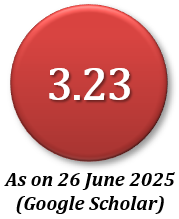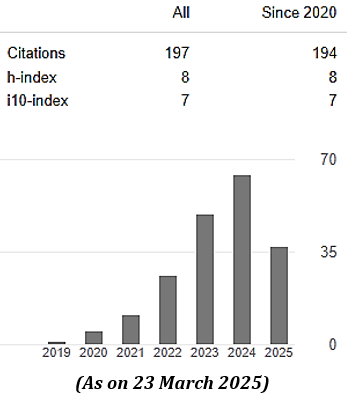ANALYSIS OF MODELING RESULTS FOR RIVER BANK PROTECTION OF THE MOST VULNERABLE PART OF TAZUMUDDIN UPAZILA UNDER BHOLA DISTRICT
Abstract
Bhola is the largest Island of Bangladesh situated in the south central region (latitude approximately from 430000N to
525000N and longitude 555000E to 590000E) of Bangladesh in the highly dynamic Meghna Estuary. In recent years
the erosion along eastern shoreline of Bhola Island has become a serious issue. Attempts are taken to establish the
base line condition to simulate the natural phenomena. Baseline condition for Tazumuddin Upazilla (under Bhola
district) has been developed based on hydrodynamic and morphological modelling and historical data of bank line
shifting, thalweg line shifting, bathymetric data, char movement etc. To calibrate and validate the model water levels
and discharge are successfully calibrated. From modeling result, erosion/deposition pattern at and outside the
protective works, new vulnerable areas due to revetment have been identified. Hydrodynamic (HD) simulations during
ebb tide the maximum depth integrated near bank velocity is found within the range of 1.5-3.0 m/s along the riverbank
of Tazumuddin and 1.0-1.5 m/s along the riverbank of Lalmohan. Morphological simulation shows the channel is
further extended towards the south-east part. Further computational simulation showed that channel in front of
Tazumuddin become deeper and it is extended more towards the south-east direction. From bathymetry survey data in
May, 05 it is found that there is a tendency to deepen the channel in front of Tazumuddin where protective work was
suggested and the deep channel is further extended towards south-east direction like simulation result. So it can be
concluded that simulation result and real condition near Tazumuddin follows the same trend of channel development.
Downloads
References
2. Lawler, D. (2005). “The importance of highresolution monitoring in erosin and deposition dynamics studies: Examples from estuarine and fluvial systems.” Geomorphology, 64, 1-23.
3. Ikeda, S., Parker, G., and Sawai, K. (1981). “Bend theory of river meanders: Part I: Linear development.” J. Fluid Mech., 112, 363-377
4. Parker, G., Sawai, K., and Ikeda, S. (1982). “Bend theory of river meanders, Part II: Nonlinear deformation of finite-amplitude bends.” J.Fluid Mech., 115, 303-314.
5. Blondeaux, P., and Seminara, G. (1985). “A unified bar-bend theory of rivermeanders.” J. Fluid Mech., Cambridge, U.K., 157, 449-470.
6. Hasegawa, K., and Yamaoka, I. (1980). “The effect of plane and bedforms of channels upon the mender development.” Proc.JSCE, TOKYO,296, 143-152.
7. Johannesson, H., and Parker, G. (1989). “Velocity redistribution in me andering rivers.” J. Hydraul. Eng., 115(8), 1019-1039.
8. Hooke, J. M. (1979). “An analysis of the processes of river bank erosion.” J. Hydrol., 42, 39-62.
9. Hardy, R. J. (2006). “ Fluvial geomorphology.” Prog. Phys. Geogr., 30(4), 553-567.
10. Crosta, G., and di Prisco, C. (1999). “On slope instability induced by seepage erosion.” Can. Geotech. J., 36, 1056-1073.
11. Burgi, P.H., and Karaki, S. (1971). “Seepage effect on channel bank stability.” J. Irrig. and Drain. Div., 97, 59-72.
12. Hagerty, D. J. (1991a). “Piping/sapping erosion. I: Basic considerations.” J. Hydraul. Eng., 117(8), 991-1008.
13. Wilson, G. V., Periketi, R. K., Fox, G. A., Cullum, R. F., and Shields, F. D. (2007). “Seepage erosion and properties contributing to streambank failure.” Earth Surf. Processes Landforms, in press.
14. Fox, G. A., Wilson, G. V., Simon, A., Langendoen, E., Akay, O., and Fuchs, J.W. (2007). “ Measuring streambank erosion due to ground water seepage: Correlation to bank pore water pressure, precipitation, and stream stage.” Earth Surf. Processes Landforms, 32(10), 1558-1573.
15. Rockwell, D. L., (2002). “The influence of groundwater on surface flow erosion processes.” Earth Surf. Processes Landforms, 27(5), 495-514.
16. Huang, C., and Laflen, J. M. (1996). “Seepage and soil erosion for a clay loam soil.” Soil Sci. Soc. Am. J., 60(2), 408-416.
17. Wilson, G. V., Periketi, R. K., Fox, G. A., Dabney, S. M., Shields, F. D.,and Cullum, R. F. (2007). “Seepage erosion properties contributingto streambank failure.” Earth Surf. Processes
Landforms, 32(3), 447-459.
18. Muramoto, Y., and Fujita, Y. (1992). “Recent channel processes of the major rivers in Bangladesh.” Annuals of the Diaster Prevention Res. Inst., Kyoto Univ., Kyoto, Japan, 35 B-2, 89-
114 (in Japanese).
19. Mosselman, E., Huisink, M., Koomen, E., and Seijmonsbergen, A. C.(1995). “ Morphological changes in a large braided sand-bed river.” River Geomorphology, E. J. Hickin, ed., Wiley,
Chichester, U.K., 235-247.
20. Tingsanchali, T., and Chinnarasri, C. (1997). “Desing of Mekong river bank protection.” Proc., Conf. on Mgmt. of Landscapes Disturbed by Channel Incision, University of Mississippi, Miss., 345-348.
21. Mosselman, E. (1998). “Morphological modeling of rivers with erodible banks.” Hydrolog. Process., 12, 1357-1370.
22. Nagata, N., Hosoda, T., and Muramoto, Y. (2000). “Numerical analysis of river channel processes with bank erosion.” J. Hydraul. Eng., 126(4), 243-252.
23. Duan, J. G., Wang, S. S. Y., and Jia, Y. (2001). “The applications of the enhanced CCHE2D model to study the alluvial channel migration processes.” J. Hydraul. Res., 39, 469-480.
24. Darby, S.E., Alabyan, A. M., and Van de Wiel, M. J. (2002). “ Numerical simulation of bank erosion and channel migration in meandering rivers.” Water Resour. Res., 38(9), 2-1-2-12.
25. Report of the National Committee on Erosion of Bhola, Ministry of Irrigation, Water Development and Flood Control, April 6, 1988
26. Meghna Estuary Study, Draft Development Plan, Volume 6, Reconnaissance Studies Erosion Control, March 1999, DHV Consultants BV in association with Kampsax International, Danish Hydraulic Institute, Development Design Consultants, Surface Water Modelling Centre, Aqua Consultants and Associates Ltd.
27. Meghna Estuary Study, Technical Note MES- 022, Gravitational Circulation Shahbazpur Main Channel, September 1998, DHV Consultants BV in association with Kampsax International, Danish Hydraulic Institute, Development Design Consultants, Surface Water Modelling Centre, Aqua Consultants and Associates Ltd.
28. Meghna Estuary Study, Technical Note MES-001, Tidal Volume and Sediment Transport Patterns, June 1997, DHV Consultants BV in association with Kampsax International, Danish Hydraulic Institute, Development Design Consultants, Surface Water Modelling Centre, Aqua Consultants and Associates Ltd.
29. Meghna Estuary Study (MES II), Hydro-Morphological Dynamics of the Meghna Estuary, BoB-MoWR, GoN-DGIS, June 2001, DHV Consultants BV in association with Devconsultants Ltd. and Surface Water Modelling Centre.
30. Hydraulic Modelling Study, Second Coastal Embankment Rehabilitation Project, SWMC May 2002.
31. Technical Feasibility Study with Hydraulic Modeling for Riverbank Protection Project at Tajumuddin of Bhola District.
32. Technical Feasibility Study with Hydraulic Modeling for Meghna-Tentulia River Bank Protection Project
MIJST follows the open access policy.

This work is licensed under a Creative Commons Attribution-NonCommercial 4.0 International License. This allows anyone to copy, share, distribute, and modify the work for non-commercial purposes, where the original work and source should be properly credited.
















